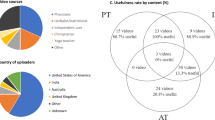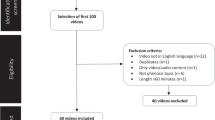Abstract
Introduction YouTube is a popular social media platform that is being increasingly used for the distribution of healthcare-related information. To date, there appear to be no published studies assessing the quality of oral hygiene instruction provided by YouTube videos.
Objective To assess the availability, quality and accuracy of patient-focused YouTube videos aiming to provide oral hygiene instruction.
Method YouTube videos meeting the inclusion criteria were evaluated for quality and information accuracy using an eight-item, evidence-based checklist relating to important aspects in the prevention of caries and periodontal disease.
Results Fifty-two relevant videos were included; 20 videos (38.5%) were produced by lay people (social media influencers and bloggers) who had no professional qualifications. None of the included videos contained accurate information relating to all eight items of the evidence-based checklist. Seven videos contained none of the information from the checklist. Numerous videos contained health advice which was not scientifically sound.
Conclusion The results of this study highlight that currently available YouTube videos may not contain evidence-based information relating to oral hygiene instruction. There are also concerns regarding the lack of regulation and quality assurance processes in the development of healthcare-related YouTube videos. Currently, clinicians should be cautious when advising patients to utilise YouTube as a source of information regarding oral health.
This is a preview of subscription content, access via your institution
Access options
Subscribe to this journal
Receive 24 print issues and online access
$259.00 per year
only $10.79 per issue
Buy this article
- Purchase on Springer Link
- Instant access to full article PDF
Prices may be subject to local taxes which are calculated during checkout



Similar content being viewed by others
References
NHS Digital, Information Centre for Health and Social Care. Adult Dental Health Survey 2009. 2011. Available at https://digital.nhs.uk/data-and-information/publications/statistical/adult-dental-health-survey/adult-dental-health-survey-2009-summary-report-and-thematic-series (accessed April 2020).
NHS Digital. Children's Dental Health Survey 2013. 2015. Available online at https://digital.nhs.uk/data-and-information/publications/statistical/children-s-dental-health-survey/child-dental-health-survey-2013-england-wales-and-northern-ireland (accessed September 2019).
Garcia R I, Sohn W. The paradigm shift to prevention and its relationship to dental education. J Dent Educ 2012; 76: 36-45.
Public Health England. Delivering Better Oral Health: An Evidence-Based Toolkit for Prevention (Third edition). 2017. Available at https://assets.publishing.service.gov.uk/government/uploads/system/uploads/attachment_data/file/605266/Delivering_better_oral_health.pdf (accessed September 2019).
NHS England. SMILE4LIFE. 2017. Available online at https://www.england.nhs.uk/primary-care/dentistry/smile4life/ (accessed September 2019).
NHS England. Avoidance of Doubt: Provision of Phased Treatments. 2018. Available at https://www.england.nhs.uk/wp-content/uploads/2018/02/avoidance-of-doubt-provision-of-phased-treatments-v20.pdf (accessed September 2019).
Ramsey I, Corsini N, Peters M D J, Eckert M. A rapid review of consumer health information needs and preferences. Patient Educ Couns 2017; 100: 1634-1642.
Centre for Studying Health System Change. Health tracking household survey, 2010. 2012. Available online at https://www.icpsr.umich.edu/web/HMCA/studies/34141/version/1 (accessed September 2019).
NHS Digital. NHS Dental Statistics for England 2018-19, Second Quarterly Report. 2019. Available at https://digital.nhs.uk/data-and-information/publications/statistical/nhs-dental-statistics/quarter-2-2018-19 (accessed September 2019).
European Commission. Flash Eurobarometer 404: European citizens' digital health literacy. 2014. Available at https://ec.europa.eu/commfrontoffice/publicopinion/flash/fl_404_en.pdf (accessed September 2019).
Zhao Y, Zhang J. Consumer health information seeking in social media: a literature review. Health Info Libr J 2017; 34: 268-283.
Migiro G. Which countries watch the most YouTube? 2018. Available at https://www.worldatlas.com/articles/which-countries-watch-the-most-youtube.html (accessed September 2019).
Madathil K C, Rivera-Rodriguez A J, Greenstein J S, Gramopadhye A K. Healthcare information on YouTube: A systematic review. Health Informatics J 2015; 21: 173-194.
NHS England and NHS Improvement. NHS England and NHS Improvement YouTube channel. Available at https://www.youtube.com/user/TheNHSEngland (accessed September 2019).
NHS. NHS YouTube channel. Available at https://www.youtube.com/user/NHSChoices (accessed September 2019).
Nason K, Donnelly A, Duncan H F. YouTube as a patient-information source for root canal treatment. Int Endod J 2016; 49: 1194-1200.
Hassona Y, Taimeh D, Marahleh A, Scully C. YouTube as a source of information on mouth (oral) cancer. Oral Dis 2016; 22: 202-208.
Abukaraky A, Hamdan A A, Ameera M N, Nasief M, Hassona Y. Quality of YouTube TM videos on dental implants. Med Oral Patol Oral Cir Bucal 2018; DOI: 10.4317/medoral.22447.
Kilinc D D, Sayar G. Assessment of Reliability of YouTube Videos on Orthodontics. Turk J Orthod 2019; 32: 145-150.
Sharif M O, Alkadhimi A. Patient focused oral hygiene apps: an assessment of quality (using MARS) and knowledge content. Br Dent J 2019; 227: 383-386.
Drozd B, Couvillon E, Suarez A. Medical YouTube Videos and Methods of Evaluation: Literature Review. JMIR Med Educ 2018; DOI: 10.2196/mededu.8527.
Centers for Disease Control and Prevention. Social Media Guidelines and Best Practices: CDC YouTube Channel. 2012. Available at https://www.cdc.gov/SocialMedia/Tools/guidelines/pdf/onlinevideo.pdf (accessed September 2019).
Myneni S R. Effect of baking soda in dentifrices on plaque removal. J Am Dent Assoc 2017; DOI: 10.1016/j.adaj.2017.09.004.
Li Y. Stain removal and whitening by baking soda dentifrice: A review of literature. J Am Dent Assoc 2017; DOI: 10.1016/j.adaj.2017.09.006.
Ciancio S G. Baking soda dentifrices and oral health. J Am Dent Assoc 2017; DOI: 10.1016/j.adaj.2017.09.009.
Author contributions
Mohammad Owaise Sharif conceived the idea for this project, supervised the project and drafted the manuscript. Maya Amlani and Robert S. D. Smyth contributed equally as co-first authors. Andrew Fulton contributed to data collection and initial drafting of the manuscript.
Author information
Authors and Affiliations
Corresponding author
Rights and permissions
About this article
Cite this article
Smyth, R., Amlani, M., Fulton, A. et al. The availability and characteristics of patient-focused YouTube videos related to oral hygiene instruction. Br Dent J 228, 773–781 (2020). https://doi.org/10.1038/s41415-020-1527-5
Published:
Issue Date:
DOI: https://doi.org/10.1038/s41415-020-1527-5



